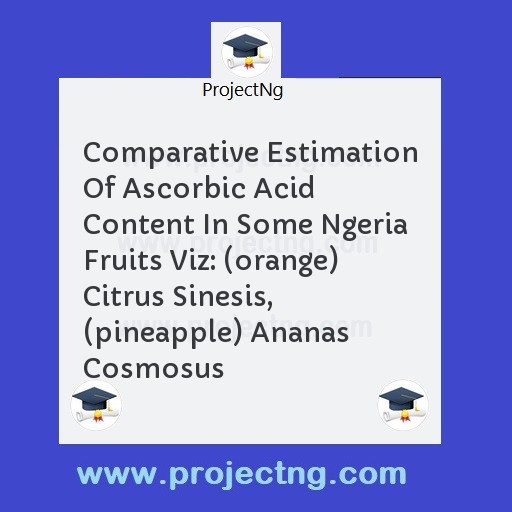Comparative Estimation Of Ascorbic Acid Content In Some Ngeria Fruits Viz: (orange) Citrus Sinesis, (pineapple) Ananas Cosmosus
Science Lab Technology Project Topics
Get the Complete Project Materials Now! »
COMPARATIVE ESTIMATION OF ASCORBIC ACID CONTENT IN SOME NGERIA FRUITS VIZ: (ORANGE) CITRUS SINESIS, (PINEAPPLE) ANANAS COSMOSUS
ABSTRACT
A comparative analysis of the ascorbic acid (vitamin C) content of some Nigerian fruits were carried out. The fruits analyzed were (Orange) Citrus Sinensis and (Pineapple) Ananas Cosmosus the fruits were bought at the Ogbete main market Enugu, Enugu State. The fruits were blended and the filterates were used for the analysis. The Ascorbic acid content of the fruits were analyzed spectrophotometrically. The result showed that (orange) Citrus Sinensis contained 7.5 x 10-2g/mol, and (pineapple) Ananas Cosmosus contained 6.0 x 10-2g/mol of Ascorbic acid content. In summary (orange) Citrus Sinensis has the highest ascorbic acid content, than the (pineapple) Ananas Cosmosus.
CHAPTER ONE
1.0 INTRODUCTION
Vitamins are organic substances found in most natural foods in rather small amounts and required by the organism in also small amount for the conduct of several chemical and biochemical processes on which the attainment of good nutritional health depends. It can also be defined as organic compounds which occur in natural foodstuffs, either as such or as utilizable precursors, and which are necessary usually in minute’s amounts, for normal growth maintenance, reproduction and health in animals.
They differ from other organic compounds of the diet in that they do not enter in to the structure of tissues (at least in the normal sense, although certain of them may function by stabilizing the integrity of cell membranes) nor do they undergo metabolism to provide energy. The discovering of vitamins the so-called accessory food factors is one of the great achievements of the 20th century. This great contribution to the science of animal and human nutrition was, in the main, conceived in terms of some what nebulous food principles brought to function in terms of modern chemistry and production virtually with the spam of one generation. Although nutritional deficiency diseases such as scurry and rickets has been down for centuries, their causes were either unknown or wrapped in mystery and also their treatment remain empirical.
However, even in the 18th and 19th centuries, it was recognized that some diseases were related to diet.
Dumes J.B.A (18000 to 1884) seems to have been the first practical scientist to question the adequacy of human diet based solely on protein, fats, carbohydrates and minerals. By 1900, several scientists all over the world carried out experiments that led to the conclusion that purified diets were unable to support life and production in animals as diverse as rats, chicks and dogs. It seemed clear that certain foodstuffs must contain small amount of substances essential for vital processes.
In 1906, Hoiptins F.G in Cambridge, England stated this idea in clear scientific terms. The classic work of Eijkman on rice and of Osborn and Mendel on milk eventually led Funk, in 1902, to propound, for the fruit time, the theory that beriberi, scurvy, pellagra and perhaps rickets were nutritional diseases caused by a lack of special substances which are of the nature of organic bases, which were called vitamins.
The concept took some years to establish, but opened the way for modern nutritional research. By the
Be the First to Share On Social

Enjoying our content?
Don't miss out on new videos! Subscribe to our YouTube channel for more awesome content.
Subscribe Now!













